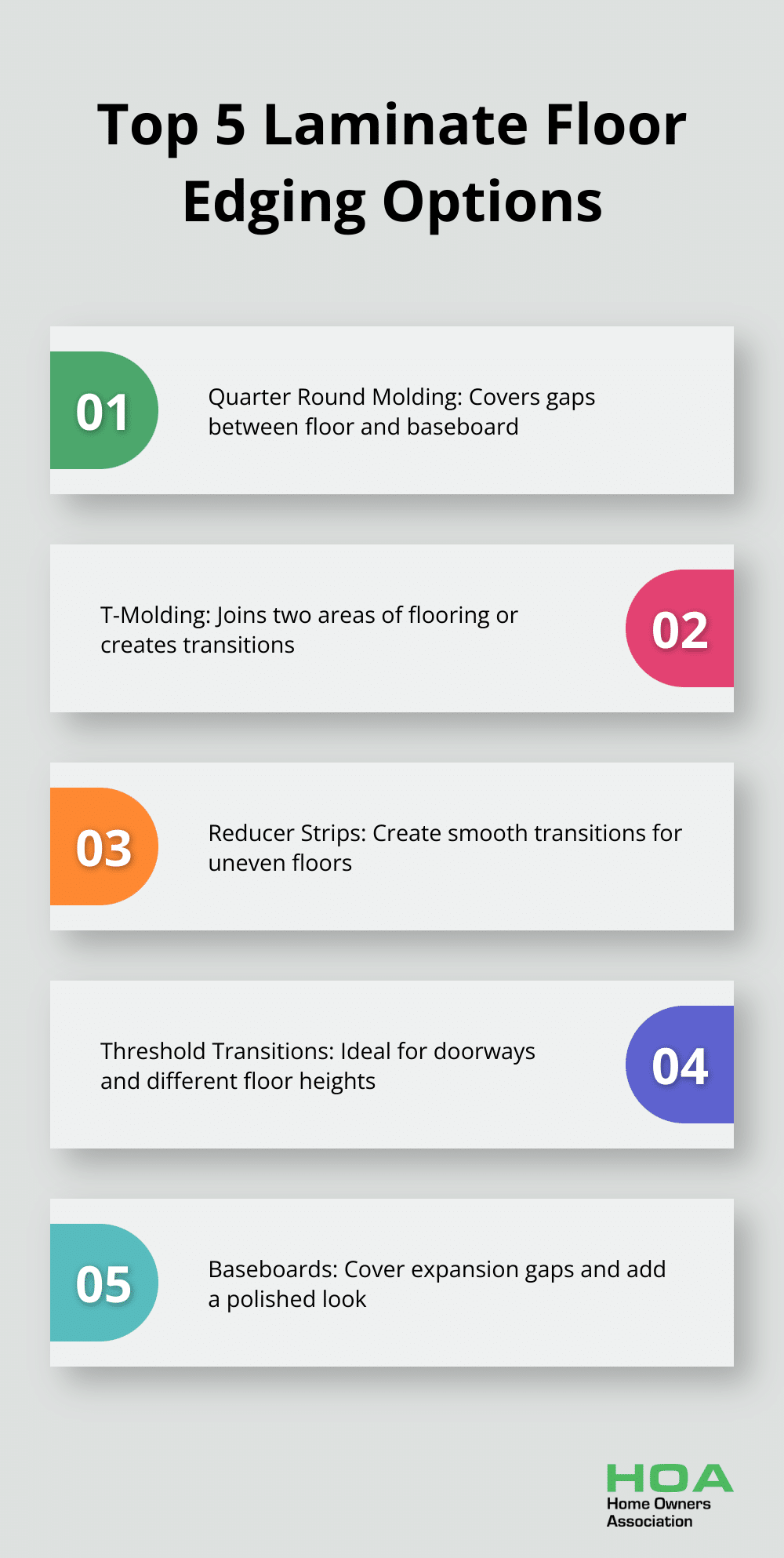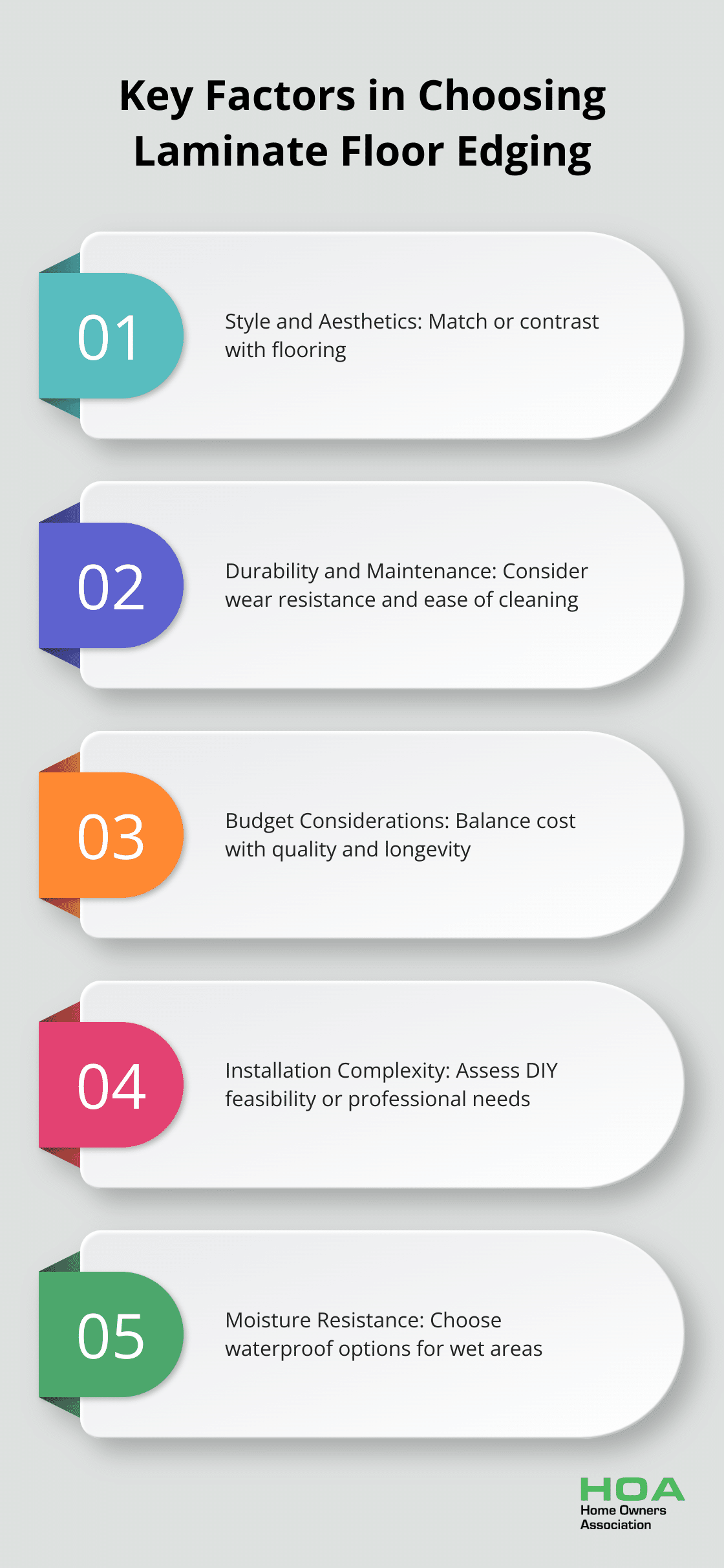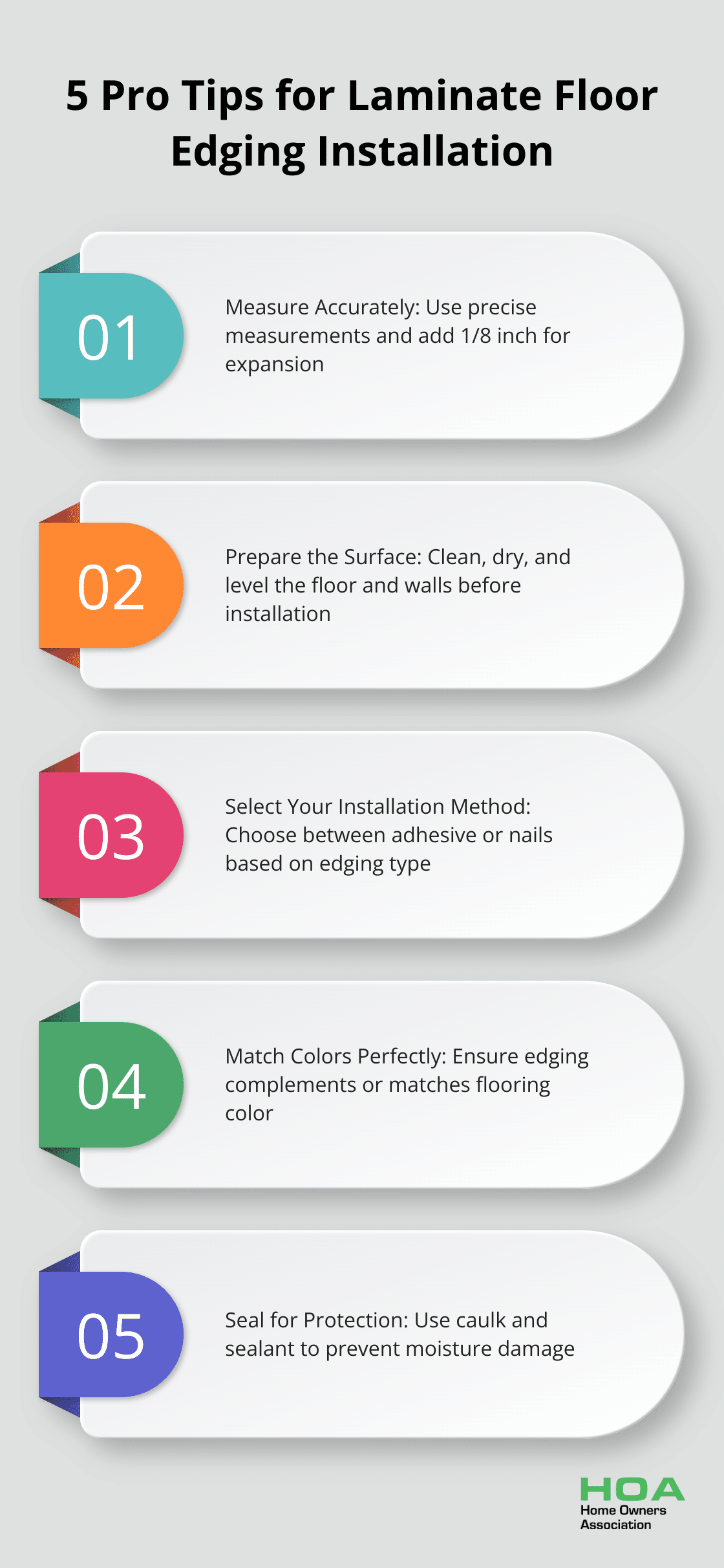
Laminate flooring has become a popular choice for homeowners, but the finishing touches can make all the difference. At Home Owners Association, we understand the importance of selecting the right laminate floor edging options to complete your home’s look.
From quarter round molding to baseboards, there are various edging solutions to consider. This guide will help you navigate through the different types, factors to keep in mind, and installation tips for a polished final result.
What Are the Best Laminate Floor Edging Options?
Selecting the right laminate floor edging will polish your home’s look and complete your flooring project. Let’s explore the top options available to you.
Quarter Round Molding: A Classic Choice
Quarter round trim is a little, adjusted embellishment that is utilized to cover the hole between the floor and the baseboard. It hides expansion gaps while adding a decorative touch.
T-Molding: Perfect for Transitions
T-molding joins two areas of laminate flooring or creates a transition to another flooring type. Without transition strips, floors can buckle, warp, or separate over time. A properly placed transition strip allows the flooring to expand and contract.
Reducer Strips: Smooth Transitions for Uneven Floors
Reducer strips create a gradual slope when your laminate flooring meets a lower surface, such as vinyl or carpet. They ensure a safe transition and prevent edge damage.
Threshold Transitions: Ideal for Doorways
Thresholds are specifically designed for doorways, providing a finished look while accommodating different floor heights. They’re available in various materials to match your laminate flooring.
Baseboards: The Finishing Touch
Baseboards play a crucial role in completing the look of your laminate flooring. They cover the expansion gap around the room’s perimeter and add a polished appearance.
When you select your laminate floor edging, consider factors like room aesthetics, durability, and ease of installation. Proper installation will maximize the benefits of these edging options. The next section will guide you through important factors to consider when choosing the right laminate floor edging for your home.

What Factors Matter When Choosing Laminate Floor Edging?
Laminate floor edging involves several key considerations. Let’s explore the factors that will help you make an informed decision for your home.
Style and Aesthetics
The edging you select should enhance your room’s design. To create a seamless look, match the edging color and texture to your laminate flooring. For a bold statement, consider edging in a contrasting shade or material. Dark wood-look laminate, for instance, pairs beautifully with lighter trim, resulting in a striking visual effect.
Durability and Maintenance
High-traffic areas require more robust edging materials. Aluminum or PVC options often outperform wood in terms of wear resistance.
Maintenance is another important aspect to consider. Some materials are easier to clean and less prone to damage. Vinyl edging, for example, only needs a quick wipe with a damp cloth, while wood might require special cleaning products and more frequent touch-ups.
Budget Considerations
Edging costs vary widely. Wood offers a classic look but often comes with a higher price tag than synthetic alternatives. PVC and aluminum options typically provide a good balance between cost and durability.
Installation Complexity
If you plan a DIY project, consider the ease of installation. T-molding and quarter round are generally easier to install than more complex options like stair nosing. However, professional installation often results in a flawless finish.
Moisture Resistance
In areas prone to moisture (such as bathrooms or kitchens), waterproof edging is essential. Look for options specifically designed to resist water damage. Waterproof vinyl or treated wood edging can prevent swelling and warping, protecting both the edging and your laminate flooring from moisture-related issues.
The right edging can elevate your entire flooring project, transforming a good room into a great one. Now that we’ve covered the key factors to consider, let’s move on to some practical installation tips that will help you achieve a professional-looking finish.

How to Install Laminate Floor Edging Like a Pro
Measure Accurately
Precise measurements form the basis of successful edging installation. Use a tape measure to determine the exact length needed for each section. Add an extra 1/8 inch to allow for expansion. When cutting, use a miter saw for precise 45-degree angle cuts at corners. This technique (known as coping) ensures a tight fit and seamless appearance.
Prepare the Surface
Before installation, clean, dry, and level the floor and walls. Remove any baseboards or existing trim. Fill gaps or uneven areas with wood filler or caulk. Allow it to dry completely before proceeding. This preparation step (often overlooked) is essential for a smooth installation process.
Select Your Installation Method
The type of edging determines whether you’ll use adhesive or nails for installation. For quarter round and baseboards, you may need to nail straight back into the base to avoid hitting the flooring. For T-molding or threshold transitions, a strong construction adhesive is often the best choice. Apply the adhesive in a zigzag pattern for maximum coverage and hold.
Match Colors Perfectly
To achieve a seamless look, match your edging color to your laminate flooring. If an exact match isn’t available, opt for a complementary shade. Some homeowners choose to paint wood trim to match their flooring perfectly. If painting, use a high-quality primer and paint designed for trim work. Apply thin coats and allow proper drying time between applications for the best results.
Seal for Protection
Once you install your edging, seal any gaps or joints. Use a color-matched caulk to fill small gaps between the edging and the wall or floor. This improves appearance and prevents moisture from seeping underneath. For wood trim, apply a clear sealant to protect against moisture and wear.
Professional installation often yields the best results, especially for complex layouts or large areas. Home Owners Association members can access discounted rates with trusted installers across Australia, which ensures top-quality workmanship for your laminate flooring project.

Final Thoughts
Laminate floor edging options enhance the overall appearance of your flooring project. Quarter round molding, T-molding, reducer strips, threshold transitions, and baseboards each serve unique purposes in completing your space. The selection process involves balancing aesthetics, durability, budget, and installation requirements.
Proper installation techniques (such as accurate measurements and surface preparation) ensure a professional finish for your laminate flooring. These methods maximize the benefits of your chosen edging and contribute to the longevity of your flooring investment. Quality installation protects your laminate flooring from wear and tear while elevating its visual appeal.
Home Owners Association provides Melbourne homeowners with expert advice and resources for laminate flooring projects. Our team offers access to trade pricing and supports your home improvement endeavors. We encourage you to explore various laminate floor edging options to enhance your home’s aesthetic appeal and value.





